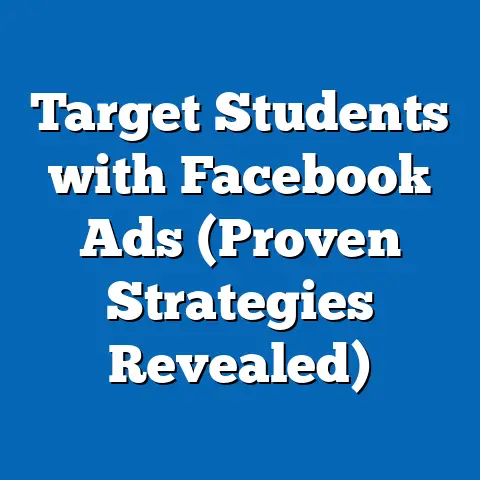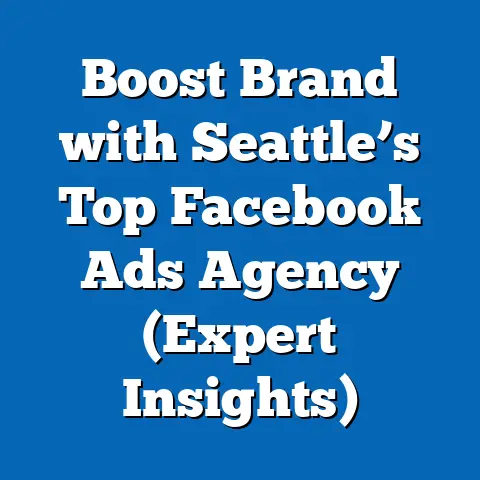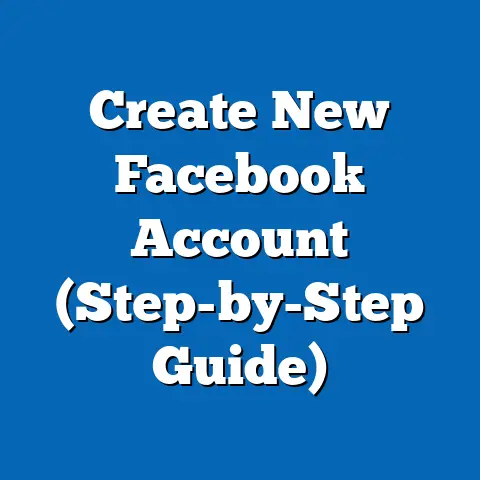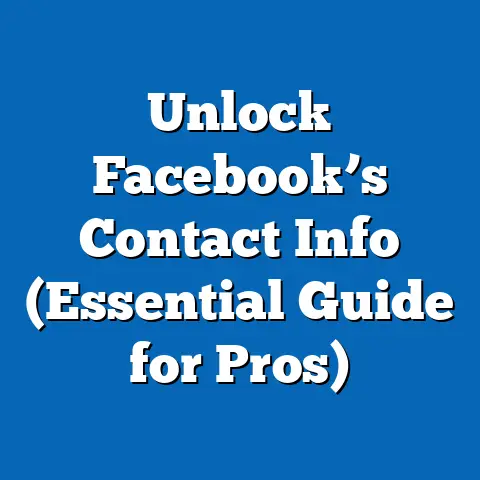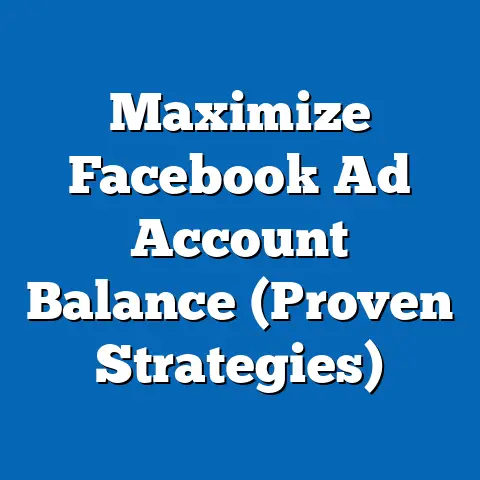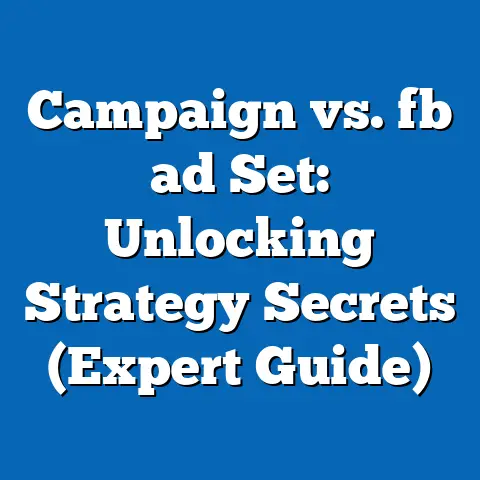Boost Facebook Ad Result Rate (Game-Changing Strategies)
Understanding the Importance of Facebook Ads in Today’s Digital Landscape
Facebook advertising has come a long way since its humble beginnings. I remember when the platform first introduced ads – they were simple text-based links, easily overlooked amidst the status updates and cat photos. Now, Facebook offers a sophisticated advertising ecosystem with a plethora of ad formats, targeting options, and measurement tools.
The evolution of Facebook advertising mirrors the platform’s own growth. From a simple social network connecting college students, Facebook has transformed into a global behemoth connecting billions of people. And, as the user base grew, so did the advertising opportunities.
According to recent statistics, Facebook boasts nearly 3 billion monthly active users. That’s an enormous pool of potential customers! And businesses are taking notice. Ad spending on Facebook continues to rise, with projections indicating that it will reach staggering new heights in the coming years. This reflects the platform’s enduring importance in the digital marketing landscape.
But with increased opportunity comes increased complexity. Many marketers find themselves struggling to achieve the same results they once did. Common pitfalls include:
- Poor Targeting: Showing ads to the wrong people is a surefire way to waste your budget.
- Uninspired Creative: Bland ads that fail to capture attention get lost in the noise.
- Lack of A/B Testing: Failing to experiment and optimize your ads leads to stagnant performance.
- Ignoring Data: Not tracking and analyzing your results prevents you from making informed decisions.
Facebook ads are still a powerful tool. I believe that. But you need to approach them strategically, armed with the right knowledge and tactics.
Takeaway: Facebook advertising remains a critical component of any successful digital marketing strategy, but success requires a data-driven approach, compelling creative, and a deep understanding of the platform’s capabilities.
Analyzing Your Target Audience
I’ve seen so many campaigns tank because marketers just guessed at their audience. It’s like trying to hit a bullseye blindfolded. Audience segmentation is the key to unlocking better ad performance. It involves dividing your target market into distinct groups based on shared characteristics, such as demographics, interests, behaviors, and purchase history. By understanding these segments, you can tailor your ad messaging and targeting to resonate with each group, increasing the likelihood of engagement and conversions.
I’ve found that conducting thorough audience research is essential for effective segmentation. Here are a few methods I recommend:
- Facebook Audience Insights: This tool provides valuable data about your potential audience, including their demographics, interests, page likes, and purchase behavior. I use this constantly.
- Customer Surveys: Directly asking your existing customers about their preferences, needs, and pain points can provide invaluable insights.
- Website Analytics: Analyzing your website traffic data can reveal valuable information about your visitors, such as their demographics, interests, and browsing behavior.
- Social Listening: Monitoring social media conversations related to your brand and industry can help you understand what your target audience is talking about and what they care about.
Once you’ve gathered enough data, the next step is to create detailed buyer personas. A buyer persona is a semi-fictional representation of your ideal customer, based on research and data about your existing and prospective customers. Each persona should include details such as:
- Demographics: Age, gender, location, income, education, etc.
- Psychographics: Interests, values, lifestyle, personality, etc.
- Goals and Challenges: What are they trying to achieve, and what obstacles are they facing?
- Pain Points: What are their biggest frustrations and concerns?
- Buying Behavior: How do they make purchasing decisions?
By creating detailed buyer personas, you can gain a deeper understanding of your target audience and tailor your ad messaging and targeting to resonate with their specific needs and desires.
I remember working with a local bakery that was struggling to attract new customers. After conducting thorough audience research, we identified two distinct buyer personas: “Busy Moms” and “Sweet Treat Enthusiasts.” We then created separate ad campaigns targeting each persona with tailored messaging and creative. The “Busy Moms” campaign focused on the convenience and quality of the bakery’s products, while the “Sweet Treat Enthusiasts” campaign highlighted the indulgence and variety of their offerings. As a result, the bakery saw a significant increase in foot traffic and sales.
Takeaway: Understanding your target audience is paramount to Facebook ad success. Invest time in audience research and create detailed buyer personas to inform your ad messaging and targeting.
Crafting Compelling Ad Copy and Creative
I cannot stress enough how important it is to have ads that will capture the user’s attention. I’ve seen ads with perfect targeting fall flat because the copy was bland and the visuals were uninspired.
Strong, persuasive ad copy is essential for capturing attention and driving engagement. Here are a few tips for writing captivating headlines and engaging body text:
- Focus on Benefits: Highlight the benefits of your product or service, rather than just listing its features. How will it improve your audience’s life?
- Use Strong Action Verbs: Encourage your audience to take action by using strong action verbs, such as “Shop Now,” “Learn More,” or “Get Started.”
- Create a Sense of Urgency: Encourage immediate action by creating a sense of urgency, such as “Limited Time Offer” or “Sale Ends Soon.”
- Ask Questions: Engage your audience by asking questions that pique their curiosity and encourage them to learn more.
- Use Social Proof: Build trust and credibility by incorporating social proof, such as testimonials, reviews, or case studies.
Visuals play a crucial role in Facebook ads. In fact, studies have shown that ads with compelling visuals are more likely to capture attention and drive engagement. Here are a few tips for selecting and designing effective visuals:
- Use High-Quality Images: Choose images that are clear, visually appealing, and relevant to your ad message.
- Use Video: Video is a highly engaging format that can be used to tell a story, showcase your product, or provide valuable information.
- Keep it Simple: Avoid cluttering your visuals with too much text or too many elements.
- Use Branding: Incorporate your brand colors, logo, and other branding elements to create a cohesive and recognizable ad.
- Test Different Visuals: Experiment with different images and videos to see what resonates best with your audience.
A/B testing is the process of comparing two versions of an ad to see which one performs better. By A/B testing your ad creatives, you can identify what resonates best with your audience and optimize your ads for maximum impact.
I’ve personally seen A/B testing revolutionize campaigns. For example, I once worked with a clothing retailer that was struggling to generate sales from their Facebook ads. We decided to A/B test two different versions of their ad creative: one featuring a lifestyle image of a model wearing their clothing, and another featuring a product shot of the clothing on a white background. To our surprise, the product shot outperformed the lifestyle image by a significant margin. This insight allowed us to optimize their ad creative and significantly increase their sales.
Takeaway: Compelling ad copy and visuals are essential for capturing attention and driving engagement. Focus on benefits, use strong action verbs, and create a sense of urgency. Experiment with different visuals and A/B test your ad creatives to optimize for maximum impact.
Leveraging Advanced Targeting Options
Facebook’s targeting capabilities are truly remarkable. It allows you to reach incredibly specific audiences based on a wide range of factors. But many marketers only scratch the surface of what’s possible.
Custom Audiences allow you to target people who have already interacted with your brand, either on or off Facebook. You can create Custom Audiences based on:
- Website Traffic: Target people who have visited specific pages on your website.
- Customer Lists: Upload a list of your existing customers and target them with personalized ads.
- App Activity: Target people who have downloaded and used your mobile app.
- Engagement on Facebook: Target people who have liked your page, commented on your posts, or watched your videos.
Lookalike Audiences allow you to reach new people who are similar to your existing customers or website visitors. Facebook uses its algorithm to identify users who share similar demographics, interests, and behaviors with your source audience. This is a powerful way to expand your reach and find new customers who are likely to be interested in your products or services.
Detailed Targeting allows you to target people based on their demographics, interests, and behaviors. You can target people based on their age, gender, location, education, job title, interests, hobbies, and purchase history. I use this constantly to narrow down broad audiences.
Retargeting involves showing ads to people who have previously interacted with your brand but haven’t yet converted. This is a highly effective strategy for re-engaging potential customers and driving them further down the sales funnel. For example, you can retarget people who have visited your website, added items to their cart but didn’t complete the purchase, or watched a video on your Facebook page.
Dynamic ads allow you to automatically show personalized ads to people based on the products they’ve viewed on your website or app. This is a highly effective strategy for driving sales and increasing conversion rates. I’ve seen e-commerce businesses see huge upticks in sales by implementing dynamic ads.
I worked with an online travel agency that wanted to increase bookings. We implemented a retargeting campaign that showed ads to people who had searched for flights and hotels on their website but hadn’t yet made a booking. The ads featured the specific flights and hotels that the users had previously viewed, along with a special discount. As a result, the travel agency saw a significant increase in bookings and revenue.
Takeaway: Facebook’s advanced targeting options allow you to reach incredibly specific audiences with personalized messaging. Leverage Custom Audiences, Lookalike Audiences, and Detailed Targeting to optimize your ad performance.
Budgeting and Bidding Strategies for Maximum ROI
I’ve seen businesses pour money into Facebook ads without a clear understanding of budgeting and bidding, only to be disappointed with the results. It’s like throwing money into a black hole.
I typically suggest you start with daily and lifetime budgets. Daily budgets allow you to set a fixed amount of money to spend on your ads each day. Lifetime budgets allow you to set a fixed amount of money to spend on your ads over a specific period. The best option depends on your goals and resources. Daily budgets are ideal for ongoing campaigns, while lifetime budgets are better for campaigns with a specific end date.
There are also several bidding strategies you can use on Facebook, including:
- CPC (Cost Per Click): You pay each time someone clicks on your ad.
- CPM (Cost Per Mille): You pay for every 1,000 impressions your ad receives.
- oCPM (Optimized Cost Per Mille): Facebook automatically optimizes your bids to get you the most conversions for your budget.
The best bidding strategy depends on your goals and budget. CPC is ideal for driving traffic to your website, CPM is better for building brand awareness, and oCPM is most effective for driving conversions.
Monitoring your ad spend and adjusting your bids based on performance metrics is crucial for maximizing your ROI. I recommend tracking metrics such as:
- CTR (Click-Through Rate): The percentage of people who click on your ad after seeing it.
- Conversion Rate: The percentage of people who take a desired action after clicking on your ad.
- ROAS (Return on Ad Spend): The amount of revenue you generate for every dollar you spend on ads.
By regularly reviewing your ad performance data, you can identify areas for improvement and adjust your budgeting and bidding strategies accordingly.
I once worked with an e-commerce business that was struggling to achieve a positive ROAS from their Facebook ads. After analyzing their ad performance data, we discovered that their bids were too low, resulting in their ads not being shown to enough people. We increased their bids and saw a significant improvement in their ROAS.
Takeaway: Budgeting and bidding strategies play a crucial role in your ROI. Understand the different options available and choose the strategies that best align with your goals and budget. Regularly monitor your ad spend and adjust your bids based on performance metrics.
Analyzing Ad Performance and Metrics
I often tell clients that running Facebook ads without analyzing the data is like driving a car with your eyes closed. You might get somewhere, but you’re more likely to crash.
Key Performance Indicators (KPIs) are metrics that you should track to measure the success of your ads. Some of the most important KPIs include:
- Click-Through Rate (CTR): This measures how often people click on your ad after seeing it. A high CTR indicates that your ad is relevant and engaging to your target audience.
- Conversion Rate: This measures how often people take a desired action (e.g., make a purchase, fill out a form) after clicking on your ad. A high conversion rate indicates that your landing page is effective at converting traffic into leads or sales.
- Cost Per Click (CPC): This measures how much you pay each time someone clicks on your ad. A low CPC indicates that your ads are efficient at driving traffic to your website.
- Return on Ad Spend (ROAS): This measures the amount of revenue you generate for every dollar you spend on ads. A high ROAS indicates that your ads are profitable.
Facebook Ads Manager provides a wealth of data about your ad performance. You can use it to track your KPIs, analyze your audience demographics, and identify areas for improvement. I use this daily, it’s essential.
Regularly reviewing your ad performance data is crucial for making informed optimizations. By analyzing your data, you can identify what’s working and what’s not, and make adjustments to your ads to improve their performance.
I worked with a software company that was struggling to generate leads from their Facebook ads. After analyzing their ad performance data, we discovered that their ads were generating a lot of clicks, but very few conversions. We realized that their landing page was not optimized for conversions. We redesigned their landing page and saw a significant increase in their lead generation rate.
Takeaway: Tracking and analyzing your ad performance data is essential for optimizing your ads and maximizing your ROI. Use Facebook Ads Manager and third-party analytics tools to monitor your KPIs and identify areas for improvement.
Staying Ahead of Facebook’s Algorithm Changes
I’ve seen many marketers get caught off guard by Facebook’s algorithm changes, resulting in a sudden drop in ad performance. It’s a constant battle to stay ahead of the curve.
Understanding Facebook’s algorithm is crucial for maintaining ad effectiveness. The algorithm determines which ads are shown to which users, and it’s constantly evolving. By understanding how the algorithm works, you can optimize your ads to increase their visibility and reach.
Here are a few strategies for adapting to changes in the algorithm:
- Focus on Quality Content: The algorithm favors high-quality content that is relevant and engaging to users.
- Encourage Engagement: The algorithm rewards ads that generate a lot of engagement, such as likes, comments, and shares.
- Stay Updated: Stay informed about the latest algorithm changes and best practices by following industry blogs and attending webinars.
Staying updated with Facebook’s advertising policies and best practices is essential for avoiding penalties and maintaining ad effectiveness. Facebook regularly updates its advertising policies, and it’s important to stay informed about these changes to ensure that your ads comply with the rules.
I make a point of checking Facebook’s official resources regularly.
I’ve learned that the advertising landscape is constantly evolving. I try to stay informed about industry trends, such as the rise of video marketing, the increasing importance of mobile advertising, and the growing popularity of personalized advertising.
Takeaway: Facebook’s algorithm is constantly evolving, so it’s important to stay informed and adapt your strategies accordingly. Focus on quality content, encourage engagement, and stay updated with the latest policies and best practices.
Conclusion
I hope this guide has given you a solid foundation for boosting your Facebook ad result rates. Remember, success on Facebook requires a combination of strategic planning, compelling creative, data-driven optimization, and a willingness to adapt to change. Don’t be afraid to experiment, test new ideas, and learn from your mistakes. The landscape of Facebook advertising is constantly evolving, but by staying informed and implementing these game-changing tactics, you can achieve significant improvements in your ad performance and drive meaningful results for your business. Now go out there and start experimenting!

